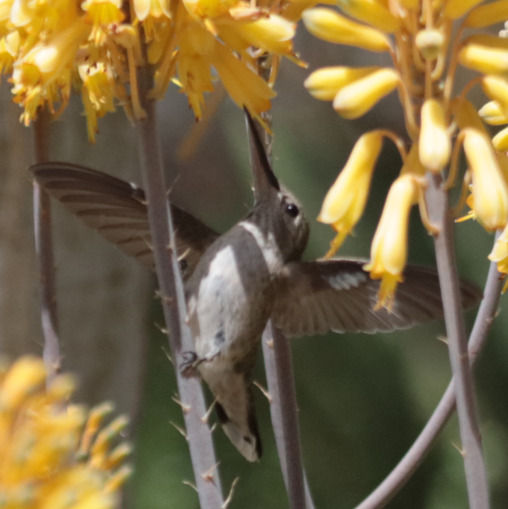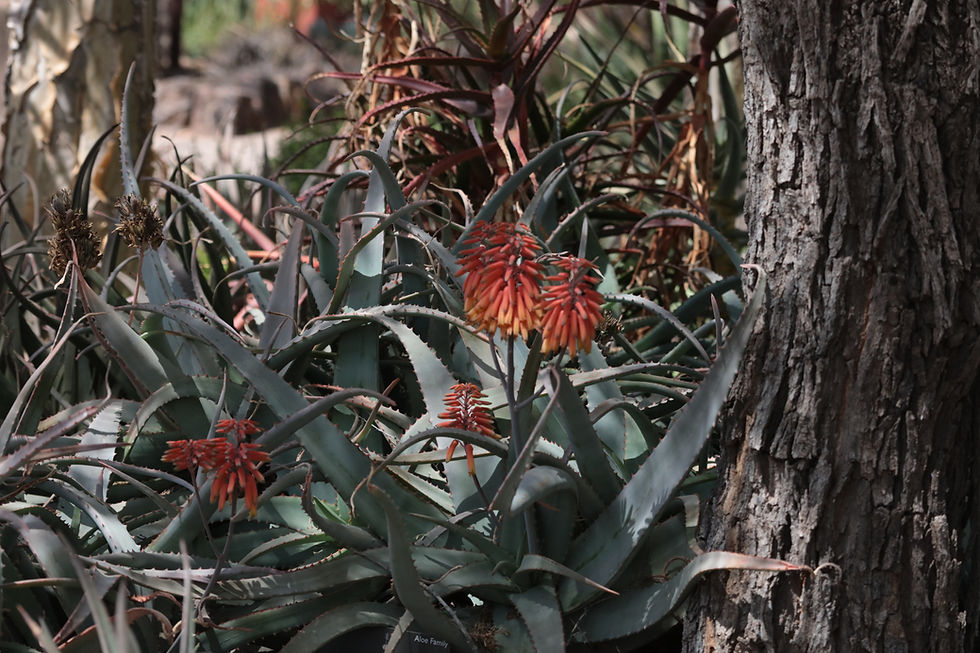Desert Botanical Garden
- Deborah Kade
- Apr 14, 2019
- 4 min read
Updated: Oct 13, 2019
It was cloudy the other day so I decided to visit the Desert Botanical Garden in Phoenix. Cloudy days are perfect for taking pictures of flowers. The temperature was a wonderful 70 degrees. Even though the garden is a short 30 minute ride from the house, it was a sunnier and warmer day there.
The Desert Botanical Garden is separated into 5 different trails. I only visited the first three.
1. Desert Discovery Loop Trail - "Stroll through the Virginia G. Piper Charitable Trust Desert Terrace Garden into the heart of Desert Botanical Garden."

2. Harriet K Maxwell Desert Wildflower Loop Trail - "Revel in the explosion of desert wildflowers and blooming cactus along Garden trails during the height of the blooming season. You might even spot three species of hummingbirds that live in the Garden. Unfortunately, I only saw one.

3. Center for Desert Living - "Immerse yourself in the colors and fragrances of this trail, which demonstrates ideas and strategies for efficient, sustainable and harmonious ways to work with nature in our desert environment."

4. Sonoran Desert Nature Loop Trail - "Hike to the top of this trail for a great view of the mountains that surround Desert Botanical Garden and Phoenix."
5. Plants & People of the Sororan Desert Loop Trail - "Explore this loop trail to see how Sonoran Desert plants have been used by native people for food, medicine and building materials. This trail is one of the largest exhibits of its kind dedicated to helping people understand the complex cultural relationships between people and plants in our region. The trail is brought to life through cultural examples of the Tohono O’odham, Western Apache and Hispanic households."
The Desert Discovery Loop Trail Pictures






According to a fact sheet from the Desert Museum, the palo verde is the primary nursing plant for baby saguaros.
There's also a species called "Desert Museum". It's named after the Arizona-Sonora Desert Museum. According to a Los Angeles Times article, the name was created about thirty years ago when staff members at the museum began to notice thorn less palo verde trees that bloomed throughout the summer.




Ocotillo prefer a habitat that is open and very rocky, and where the soil is well drained. Areas such as rocky slopes, mesas, washes and desert grasslands. Ocotillo are common in most areas of the Sonoran and Chihuahuan deserts. They are also found in western Texas through to southern California.There is much discussion on exactly how old Ocotillo can live. A good estimate is 60 years although some studies indicate they can live well over 100 years. They can reach heights of up to 20 feet.








Cactus, plural cacti or cactuses, is a flowering plant family with more than 2,000 species and about 175 genera.
Cacti are succulent perennial plants. Cacti generally have thick herbaceous or woody chlorophyll-containing stems. Cacti can be distinguished from other succulent plants by the presence of areoles, small cushion like structures with trichomes (plant hairs) and, in almost all species, spines or barbed bristles (glochids). Areoles are modified branches, from which flowers, more branches, and leaves (when present) may grow.
In most species, leaves are absent, greatly reduced, or modified as spines, minimizing the amount of surface area from which water can be lost, and the stem has taken over the photosynthetic functions of the plant. The root systems are generally thin, fibrous, and shallow, ranging widely to absorb superficial moisture.
Cacti vary greatly in size and general appearance, from button like peyote and low clumps of prickly pear and hedgehog cactus to the upright columns of barrel cacti and the imposing saguaro.
The primary method of reproduction is by seeds, Flowers, often large and colorful, are usually solitary. All genera have a floral tube, often with many petal-like structures, and other less colorful and almost leaf like structures; the tube grows above a one-chambered ovary. A style topped by many pollen-receptive stigmas also arises from the top of the ovary. The fruit is usually a berry and contains many seeds. Soon after pollination, which may be effected by wind, birds, insects, or bats the entire floral tube detaches from the top of the ovary to leave a prominent scar.






The male Gila Woodpecker enjoyed eating the flowers.




















Not all the cactus were in bloom. Sculptures are interspersed throughout the loop.




















The Gila Woodpecker was everywhere.


















































Scattered around the Garden, you come across "information tables". A woman was showing the ribs of a saguaro.

Inside of a saguaro.

Gila woodpeckers nest in saguaro cacti in holes they excavate. The woodpecker removes the pulp of the cactus, usually between the skin and the cactus ribs (the larger gilded flicker also excavates holes in saguaros). The cactus forms a “scab” on the wound that prevents water loss and infection. Because of the thermal mass of the water in saguaros, the nests are temperature controlled, often 10 to 15 degrees cooler in summer and warmer in winter. Eventually, the woodpeckers abandon the nest to seek a new abode, and the nests are then appropriated by other cavity nesters such as small owls. Females typically lay two broods a year of 3 to 5 eggs, which incubate for 14 days.

Center for Desert Living Pictures













Pomegranate bushes grow in Arizona. Pomegranate seeds get their vibrant red hue from polyphenols. These chemicals are powerful antioxidants.Pomegranate juice contains higher levels of antioxidants than most other fruit juices. It also has three times more antioxidants than red wine and green tea. The antioxidants in pomegranate juice can help remove free radicals, protect cells from damage, and reduce inflammation.
Pomegranates have an impressive nutrient profile — one cup of arils (174 grams) contains:
Fiber: 7 grams
Protein: 3 grams
Vitamin C: 30% of the RDI
Vitamin K: 36% of the RDI
Folate: 16% of the RDI
Potassium: 12% of the RDI
Pomegranate juice can reduce inflammation in the gut and improve digestion. It may be beneficial for people with Crohn's disease, ulcerative colitis, and other inflammatory bowel diseases.







Harriet K Maxwell Desert Wildflower Loop Trail
Came across another "information table".




Learn about insect hotels.





The Spring Butterfly Exhibit is also located along the route. Hundred of butterflies native to the Southwest greet you once you enter the exhibit. You have to be very careful where you step! Butterflies are everywhere. You can learn more about the butterfly life cycle in the caterpillar nursery. There are butterflies emerging from their chrysalis, too.



















This butterfly just emerged. It will take a few hours for the wings to dry and firm up.





I saw many children playing the game. I believe there is a prize if you bring the sheet back to ticket booth.







Comments